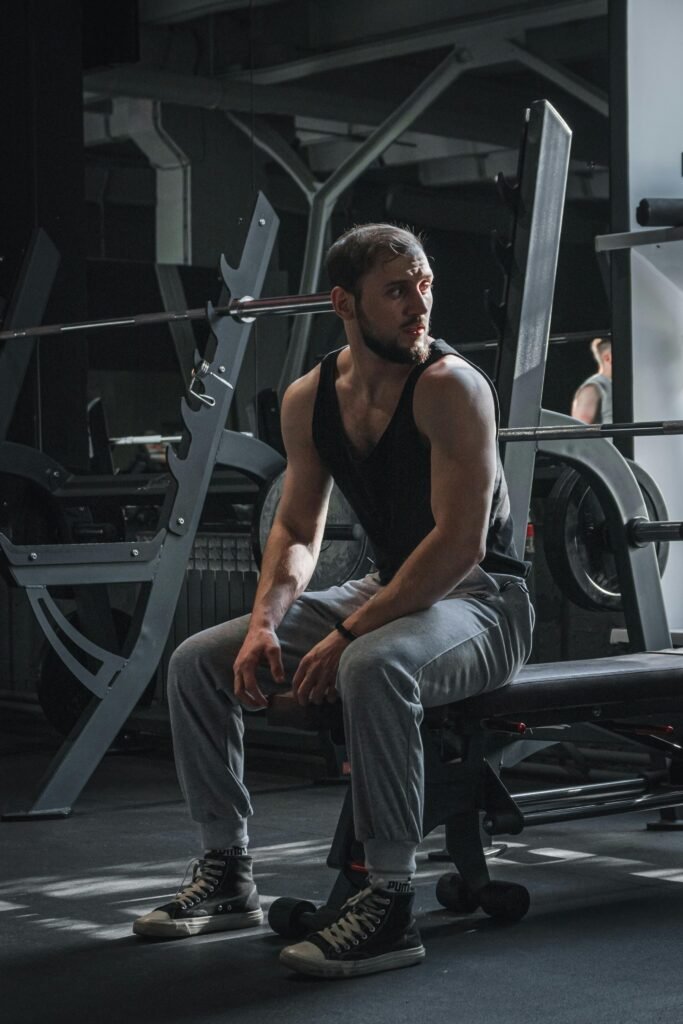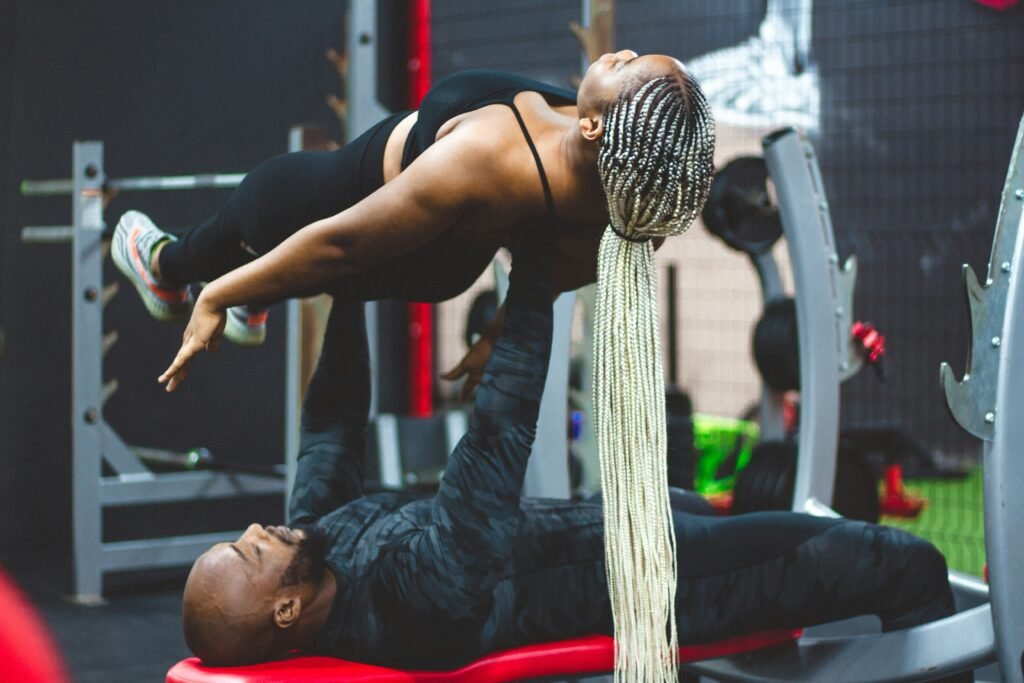
You’re searching for a way to take your fitness routine to the next level, but you don’t want to invest in expensive gym equipment or dedicate hours to complicated workout regimens. Look no further, because “Mastering Effective Workouts with Minimal Equipment” has got you covered. In this article, you’ll discover how to achieve incredible results with just a few simple and versatile pieces of equipment, allowing you to maximize your workouts and achieve your fitness goals from the comfort of your own home. Say goodbye to the constraints of bulky machines and hello to a leaner, stronger you.

This image is property of images.pexels.com.
Understanding the Benefits of Minimal Equipment Workouts
The Importance of Minimal Equipment Workouts
When it comes to working out, many people believe that having access to fancy gym equipment or expensive machines is essential. However, minimal equipment workouts have gained popularity due to their numerous benefits. These workouts primarily utilize bodyweight exercises and simple pieces of equipment, making them accessible to a wide range of individuals. Whether you’re a beginner looking to get started or a seasoned fitness enthusiast, minimal equipment workouts can help you achieve your fitness goals.
Advantages of Using Minimal Equipment for Workouts
There are several advantages to incorporating minimal equipment into your workout routine. Firstly, minimal equipment workouts are highly cost-effective. Gym memberships and equipment can be quite expensive, but with minimal equipment workouts, you can achieve similar results without breaking the bank. Additionally, minimal equipment workouts are incredibly versatile, allowing you to perform a variety of exercises and target different muscle groups. This versatility also makes it possible to complete workouts in various settings, such as at home, in a park, or while traveling. Another advantage of minimal equipment workouts is their ability to improve functional strength and stability, as they often involve movements that mimic real-life activities. Moreover, these workouts can be easily modified to accommodate different fitness levels, making them suitable for individuals of all ages and abilities.
Essential Equipment for Effective Workouts
Determining the Necessary Equipment
When it comes to minimal equipment workouts, determining the necessary equipment depends on your individual fitness goals and preferences. However, there are a few key pieces of equipment that are commonly used in these types of workouts.
Must-Have Equipment for Minimal Equipment Workouts
-
Resistance Bands: Resistance bands are one of the most versatile and affordable pieces of equipment for minimal equipment workouts. They come in different resistance levels, allowing you to adjust the intensity of your exercises. Resistance bands can be used for various exercises, targeting different muscle groups, and they are especially useful for improving strength and flexibility.
-
Dumbbells: Dumbbells are another essential piece of equipment in minimal equipment workouts. They are available in different weights, making them suitable for individuals of all fitness levels. Dumbbells can be used for a wide range of exercises, including both upper and lower body movements, helping you build strength and increase muscle mass.
-
Kettlebells: Kettlebells are a versatile tool for functional workouts that target multiple muscle groups simultaneously. They are ideal for exercises such as swings, lunges, and Turkish get-ups. Kettlebells provide an effective way to improve strength, power, and cardiovascular endurance.
-
Jump Rope: Jump ropes are excellent for cardiovascular workouts and improving overall conditioning. They are portable, affordable, and provide an intense full-body workout. Jump rope exercises can be easily modified to suit different fitness levels, making them suitable for beginners and advanced individuals alike.
-
Stability Ball: Stability balls are excellent for core strengthening exercises. They challenge your balance and stability, engaging your core muscles throughout various movements. Stability ball exercises can be performed for core strength, flexibility, and improved posture.
Affordable and Versatile Equipment Options
If you’re looking for affordable and versatile equipment options for your minimal equipment workouts, you can consider using resistance bands, which come in a set or individual bands of varying resistance levels. These bands are compact, lightweight, and can be easily stored or taken along when traveling. Another affordable and versatile equipment option is a set of adjustable dumbbells, which allow you to change the weight according to your specific needs. Kettlebells are also available in various weights and are relatively affordable compared to other fitness equipment. Additionally, jump ropes and stability balls are inexpensive and offer a wide range of exercise possibilities without taking up much space.

This image is property of images.pexels.com.
Maximizing Bodyweight Exercises
Overview of Bodyweight Exercises
Bodyweight exercises are an integral part of minimal equipment workouts. They utilize the individual’s own body weight as resistance, eliminating the need for additional equipment or weights. These exercises focus on improving strength, flexibility, endurance, and overall body control. Bodyweight exercises can be done anywhere and are highly effective at targeting multiple muscle groups simultaneously.
Benefits of Bodyweight Exercises
One of the key benefits of bodyweight exercises is that they require minimal equipment or none at all, making them accessible to individuals with limited resources or space. They also engage the stabilizing muscles, improving overall balance and coordination. Bodyweight exercises are known to be functional, as they often mimic everyday movements and improve core strength. Moreover, bodyweight exercises can be easily modified to increase or decrease the intensity, making them suitable for beginners and advanced fitness enthusiasts alike.
Variations of Bodyweight Exercises for Different Muscle Groups
Bodyweight exercises offer a wide variety of movements to target different muscle groups effectively. Here are some examples of bodyweight exercises for various muscle groups:
-
Upper Body:
- Push-Ups: Target the chest, shoulders, and triceps.
- Pull-Ups or Chin-Ups: Engage the back and biceps.
- Dips: Work your triceps, chest, and shoulders.
-
Lower Body:
- Squats: Engage the quadriceps, hamstrings, and glutes.
- Lunges: Target the quads, glutes, and hamstrings.
- Step-Ups: Work the quads, hamstrings, and glutes.
-
Core:
- Planks: Engage the entire core, including the abs and back muscles.
- Mountain Climbers: Work the abs, obliques, and hip flexors.
- Russian Twists: Target the obliques and abdominal muscles.
By incorporating these variations into your minimal equipment workouts, you can effectively target all major muscle groups and achieve a well-rounded fitness routine.
Incorporating Resistance Bands into Your Routine
Benefits of Resistance Bands
Resistance bands offer several advantages when incorporated into your workout routine. Firstly, they provide a constant tension throughout the entire range of motion, making the exercises more challenging. This helps improve strength, endurance, and muscle definition. Resistance bands also allow for a greater range of motion compared to traditional weights, enhancing flexibility. Moreover, resistance bands help improve joint stability by activating the smaller stabilizing muscles. They are also lightweight, portable, and affordable, making them a great addition to any minimal equipment workout routine.
Types of Exercises That Can Be Done with Resistance Bands
Resistance bands can be used for a wide variety of exercises. Here are some examples of exercises that can be done using resistance bands:
-
Banded Squats: Place the resistance band just above your knees and perform squats. The band adds extra resistance, targeting the glutes, quads, and hamstrings.
-
Banded Push-Ups: Loop the band around your back and hold onto the ends while performing push-ups. The band increases resistance, working your chest, shoulders, and triceps.
-
Banded Lat Pulldowns: Attach the band to a stable anchor point above you and perform lat pulldowns by pulling the band down towards your chest. This exercise targets the back muscles and biceps.
-
Banded Glute Bridges: Place the resistance band around your thighs, just above your knees, and perform glute bridges. The band adds resistance, targeting the glutes and hamstrings.
These are just a few examples of the many exercises that can be done using resistance bands. They can be incorporated into various workout routines to target specific muscle groups or add intensity to bodyweight exercises.
Proper Usage and Safety Precautions for Resistance Bands
While resistance bands are generally safe to use, it’s essential to follow some safety precautions to prevent injuries. Firstly, ensure that the resistance bands are in good condition without any tears or damages. Before each use, inspect the bands for any signs of wear and tear. Additionally, when performing exercises with resistance bands, maintain proper form and alignment to minimize the risk of strain or injury. Gradually increase the resistance of the bands as your strength and fitness levels improve, but avoid using bands that are too challenging and may compromise your form. Finally, if you experience any pain or discomfort while using resistance bands, stop the exercise and consult a healthcare professional.

This image is property of images.pexels.com.
Utilizing Dumbbells for a Well-Rounded Workout
Advantages of Using Dumbbells
Dumbbells are an excellent addition to minimal equipment workouts due to their versatility and effectiveness. One of the main advantages of using dumbbells is that they allow for a greater range of motion compared to machines, engaging more stabilizing muscles. This helps improve overall strength, stability, and coordination. Dumbbells also offer unilateral training, meaning you can work each side of the body independently, which helps correct muscle imbalances. Moreover, dumbbells are easily adjustable, allowing you to increase or decrease the weight as needed, making them suitable for individuals of all fitness levels.
Exercises Targeting Different Muscle Groups with Dumbbells
Dumbbells can be used for a wide range of exercises targeting different muscle groups. Here are some examples:
-
Shoulder Press: Stand tall with dumbbells at shoulder level, then push them upward until your arms are fully extended. This exercise targets the shoulder muscles.
-
Dumbbell Lunges: Hold a dumbbell in each hand and step forward with one leg, lowering your body until both knees are bent at a 90-degree angle. This exercise targets the quads, hamstrings, and glutes.
-
Dumbbell Rows: Bend at the waist, keeping your back straight and bracing yourself with one hand on a bench or other support. Hold the dumbbell in the opposite hand and pull it up towards your chest, engaging your back muscles.
-
Dumbbell Bicep Curls: Stand with a dumbbell in each hand, palms facing forward. Keeping your elbows close to your sides, curl the dumbbells up towards your shoulders, engaging the biceps.
These exercises are just a few examples of the many possibilities with dumbbells. By incorporating dumbbell exercises into your minimal equipment workouts, you can effectively target and strengthen different muscle groups.
Tips for Maximizing Dumbbell Workouts
To maximize your dumbbell workouts, consider the following tips:
-
Start with lighter weights: If you’re new to using dumbbells or haven’t worked out in a while, start with lighter weights and focus on perfecting your technique before increasing the weight.
-
Engage your core: Throughout dumbbell exercises, remember to engage your core muscles to build a strong foundation and maintain stability.
-
Vary your grip: Experiment with different grips to target different muscles. For example, a neutral grip (palms facing each other) during bicep curls can engage the brachialis muscle.
-
Focus on proper form: Proper form is crucial to prevent injuries and get the most out of your dumbbell workouts. Take the time to learn and practice each exercise with proper technique.
By incorporating these tips, you can enhance the effectiveness of your dumbbell workouts and continue challenging yourself as you progress.
Harnessing the Power of Kettlebells
Exploring Kettlebell Exercises
Kettlebells have become increasingly popular in minimal equipment workouts due to their unique shape and functional benefits. Kettlebells feature a handle attached to a solid iron or steel ball, allowing for versatile exercises that engage multiple muscle groups simultaneously. Unlike dumbbells, the center of gravity in a kettlebell is located away from the grip, challenging stability and coordination.
Benefits of Kettlebell Workouts
Utilizing kettlebells in your minimal equipment workouts offers numerous benefits. Firstly, kettlebell exercises often involve explosive movements, which help improve power, strength, and cardiovascular fitness. These exercises engage the entire body, making them highly efficient for burning calories and increasing overall endurance. Kettlebell workouts emphasize functional movements and improve core stability, making them particularly beneficial for athletes or individuals looking to improve their performance in sports or daily activities. Moreover, kettlebells are available in a wide range of weights, allowing individuals of all fitness levels to participate and progress.
Safety Tips for Using Kettlebells
When incorporating kettlebells into your workout routine, it’s crucial to prioritize safety. Here are some tips to ensure safe and effective kettlebell workouts:
-
Start with proper form: Before progressing to more advanced exercises, ensure you have mastered the basic kettlebell movements with proper form. This will help prevent injuries and maximize the benefits of the workouts.
-
Choose an appropriate weight: Select a weight that challenges you while still allowing you to maintain good form throughout the exercises. It’s better to start with a lighter weight and gradually progress as your strength improves.
-
Engage your core: Kettlebell exercises heavily rely on core stability and engagement. Focus on maintaining a strong and stable core throughout the movements.
-
Maintain control: The momentum generated by kettlebell exercises can be intense. Always maintain control over the kettlebell during each movement to avoid injuries.
-
Warm up and cool down: Prior to starting a kettlebell workout, engage in a thorough warm-up routine that incorporates dynamic stretches and mobility exercises. Similarly, cool down with static stretches to prevent muscle soreness and promote flexibility.
By following these safety tips, you can safely and effectively harness the power of kettlebells in your minimal equipment workouts.
Incorporating Jump Ropes for Cardio and Conditioning
Benefits of Jump Rope Exercises
Jump rope exercises provide a fun and effective way to improve cardiovascular fitness and overall conditioning. Jumping rope offers numerous benefits, including:
-
Increased calorie burn: Jumping rope at a moderate to high intensity can burn a significant amount of calories in a short period, making it an efficient way to lose weight and improve cardiovascular health.
-
Improved coordination and agility: Jumping rope requires coordination between your hands and feet, helping improve overall body coordination and agility.
-
Boosted cardiovascular endurance: Regular jump rope workouts can increase your cardiovascular endurance, improving your heart and lung health.
-
Enhanced bone density: Jumping rope is considered a weight-bearing exercise, which helps promote healthy bone density and reduce the risk of osteoporosis.
Jump Rope Workouts for Cardiovascular Endurance
To maximize cardiovascular endurance with jump rope exercises, consider the following workout routines:
-
Interval Training: Alternate between periods of high-intensity jumping and active rest periods. For example, jump at a fast pace for 30 seconds, followed by 15 seconds of slower jumping. Repeat this cycle for a set duration.
-
Tabata Workout: Perform jump rope exercises at maximum effort for 20 seconds, followed by a 10-second rest. Repeat this cycle eight times for a total of four minutes.
-
Pyramid Workout: Start with a short interval (e.g., 20 seconds) of jumping rope, followed by a brief rest. Gradually increase the duration of each interval (e.g., by five seconds) until reaching a peak, then decrease the duration back to the starting point.
-
Cardio Circuit: Incorporate jump rope intervals into a circuit training routine. Alternate between jump rope exercises and other cardiovascular exercises such as burpees, jumping jacks, or high knees.
By incorporating these jump rope workouts into your routine, you can improve your cardiovascular endurance and experience the numerous benefits of jump rope exercises.
Jump Rope Exercises for Full-Body Conditioning
Jump rope exercises can also be used to achieve full-body conditioning. Consider adding these exercises to your minimal equipment workouts:
-
Double-Unders: Perform a regular jump rope motion, but rotate the rope twice per jump. This exercise requires timing, coordination, and increases the intensity of the workout.
-
Single-Leg Jumps: Jump on one leg while keeping the other leg lifted slightly off the ground. Alternate between legs throughout the exercise to engage your lower body and challenge your balance.
-
Jumping Jacks: Instead of the traditional jump rope motion, perform jumping jacks by jumping and spreading your legs out to the sides while swinging the rope overhead.
-
Side-to-Side Jumps: Jump laterally from side to side, keeping your feet close together. This exercise targets the inner and outer thighs, calves, and helps improve overall coordination.
These full-body jump rope exercises can be incorporated into your minimal equipment workouts to add variety, challenge different muscle groups, and maintain overall conditioning.
Using Stability Balls for Core Strengthening
Benefits of Stability Ball Exercises
Stability balls, also known as exercise or Swiss balls, are excellent tools for core strengthening exercises. Using a stability ball during your minimal equipment workouts offers several benefits:
-
Improved stability and balance: Due to the unstable nature of stability balls, exercises performed on them engage the core muscles to maintain balance and stability, ultimately improving core strength.
-
Increased muscle activation: Stability ball exercises activate more muscle fibers compared to exercises performed on stable surfaces, enabling you to work your core muscles more effectively.
-
Corrected posture and alignment: Utilizing a stability ball during exercises forces proper posture and alignment, reducing the risk of muscle imbalances and promoting better overall form.
-
Enhanced flexibility and range of motion: The use of a stability ball allows for a greater range of motion during exercises, which can help improve flexibility and joint mobility.
Core Exercises Using Stability Balls
Here are some core exercises you can incorporate into your minimal equipment workouts using a stability ball:
-
Stability Ball Plank: Place your forearms on the stability ball, keeping your body in a straight line from your head to your feet. Engage your core and hold the position for a set amount of time, focusing on maintaining stability.
-
Stability Ball Russian Twist: Sit on the stability ball with your feet firmly planted on the ground. Lean back slightly while keeping your back straight. Hold a weight or medicine ball with both hands and rotate your torso from side to side, engaging your obliques.
-
Stability Ball Ab Rollout: Start in a kneeling position with your arms extended and hands on the stability ball. Roll the stability ball forward while maintaining a straight line from your head to your knees. Engage your core and control the movement as you roll the ball back to the starting position.
-
Stability Ball Reverse Hyperextension: Lie face down on the stability ball with your hands placed on the ground for support. Extend your legs back and lift them upward, engaging your lower back and glutes. Lower your legs back down to complete one rep.
These exercises are effective at targeting the core muscles while also engaging other muscle groups. Incorporating stability ball exercises into your routine can help strengthen your core, improve stability, and enhance overall functional fitness.
Proper Techniques and Precautions for Stability Ball Workouts
To ensure safe and effective stability ball workouts, keep the following tips in mind:
-
Choose the appropriate size: Select a stability ball with the correct size for your height. When sitting on the ball, your feet should be flat on the ground with your knees at a 90-degree angle.
-
Inflate the ball correctly: Properly inflate the stability ball according to the manufacturer’s instructions. Overinflating or underinflating the ball can affect stability and increase the risk of injury.
-
Start with basic exercises: If you’re new to stability ball workouts, begin with foundational exercises before progressing to more advanced movements. This allows your body to adapt to the stability challenge.
-
Focus on stability, not speed: Stability ball exercises require control and balance. Focus on maintaining stability throughout each exercise rather than rushing through them.
By following these techniques and taking necessary precautions, you can safely incorporate stability ball exercises into your minimal equipment workouts to strengthen your core and improve overall stability.
Exploring Bodyweight Suspension Training
Understanding Suspension Trainers
Bodyweight suspension trainers, often referred to as suspension straps, are a versatile piece of equipment used in minimal equipment workouts. These straps consist of adjustable handles and straps that can be attached to a stable anchor point, such as a door frame or sturdy beam. Suspension trainers leverage body weight as resistance to target multiple muscle groups effectively.
Benefits of Bodyweight Suspension Training
Incorporating bodyweight suspension training into your workout routine offers several advantages. Firstly, suspension trainers provide a unique form of instability that engages the core muscles throughout various movements. This helps improve stability, balance, and overall core strength. Suspension training exercises can also be easily modified to accommodate different fitness levels, from beginners to advanced individuals. Additionally, suspension trainers offer a wide range of exercise possibilities, allowing you to target different muscle groups and work multiple joints simultaneously. Lastly, suspension trainers are portable and can be used in various settings, making them an excellent option for individuals with limited space or who prefer to workout at home.
Sample Exercises and Routines Using Suspension Trainers
Here are some sample exercises and routines that can be performed using suspension trainers:
-
Suspended Push-Ups: Anchor the straps above head height and hold the handles with your palms facing down. Perform push-ups, keeping your body aligned and engaging your chest, shoulders, and triceps.
-
Suspended Plank: Attach the straps to a stable anchor point and place your feet in the handles, assuming a plank position with your forearms on the ground. Focus on maintaining stability and engaging your core.
-
Single-Leg Squats: Stand facing away from the anchor point, hold the handles, and lift one leg off the ground. Slowly lower yourself into a squat position using your standing leg, then push back up to the starting position.
-
Suspension Rows: Anchor the straps at waist height, hold the handles, and lean back while keeping your body aligned. Begin with straight arms, then pull your chest up towards the handles by engaging your back muscles.
Incorporate these exercises into your minimal equipment workouts to experience the benefits of bodyweight suspension training. Remember to maintain proper form and adjust the straps according to your individual needs and fitness level.
Designing Effective Workouts with Limited Equipment
Principles for Effective Workouts with Minimal Equipment
Designing effective workouts with limited equipment requires a few key principles to consider:
-
Balance: Ensure your workout routine targets all major muscle groups and incorporates both cardiovascular exercise and strength training. This helps promote overall fitness and prevents muscle imbalances.
-
Progression: As you become more comfortable with your workouts, gradually increase the intensity, resistance, or duration of exercises to continue challenging your body and making progress.
-
Variety: Keep your workouts dynamic and engaging by incorporating a variety of exercises and equipment options. This helps prevent boredom and stimulates different muscle groups.
-
Rest and Recovery: Allow your body time to rest and recover between workouts. Adequate rest helps prevent overtraining and promotes muscle growth and overall health.
Creating a Balanced Workout Routine
To create a balanced workout routine with limited equipment, consider the following guidelines:
-
Warm-Up: Begin each workout with a dynamic warm-up routine to prepare your body for exercise and reduce the risk of injury. Include movements that target major muscle groups and increase heart rate.
-
Cardiovascular Exercise: Incorporate at least two to three days of cardiovascular exercise into your routine. This can be achieved through activities such as jump rope, running, cycling, or high-intensity interval training (HIIT) exercises.
-
Strength Training: Aim for two to three days of strength training exercises targeting all major muscle groups. Utilize bodyweight exercises, resistance bands, dumbbells, kettlebells, or suspension trainers to perform exercises that challenge different muscle groups.
-
Flexibility and Mobility: Dedicate time to stretch and improve flexibility. Include static stretches after each workout when your muscles are warm to enhance flexibility and prevent muscle tightness.
-
Rest and Recovery: Allow for at least one to two rest days per week to allow your body to recover and repair itself. Active rest days can involve low-impact activities such as yoga, stretching, or light cardio.
Tips for Progressing and Challenging Yourself with Limited Equipment
To continue progressing and challenging yourself with limited equipment, consider these tips:
-
Modify Exercises: Adjust the intensity of exercises by modifying the range of motion, adding resistance bands, or progressing to more advanced variations.
-
Increase Resistance: Gradually increase the resistance by using heavier dumbbells, kettlebells, or resistance bands as your strength improves.
-
Incorporate Timed Intervals: Instead of counting repetitions, perform exercises for a set amount of time, gradually increasing the duration to push your limits.
-
Increase Repetitions: Challenge yourself by increasing the number of repetitions for each exercise, gradually building endurance and strength.
-
Try New Equipment: Explore different types of minimal equipment, such as weighted vests, sandbags, or medicine balls, to add variety and challenge to your workouts.
By implementing these tips, you can continue progressing, challenging your body, and achieving your fitness goals with limited equipment.
In conclusion, mastering effective workouts with minimal equipment offers numerous benefits, such as affordability, versatility, and improved functional strength. By incorporating bodyweight exercises, resistance bands, dumbbells, kettlebells, jump ropes, stability balls, and suspension trainers into your routine, you can target different muscle groups, improve cardiovascular fitness, and enhance overall conditioning. Remember to prioritize safety, proper form, and progression as you design and progress through your minimal equipment workouts. With dedication and consistency, you can achieve great results and maintain a healthy, active lifestyle.


